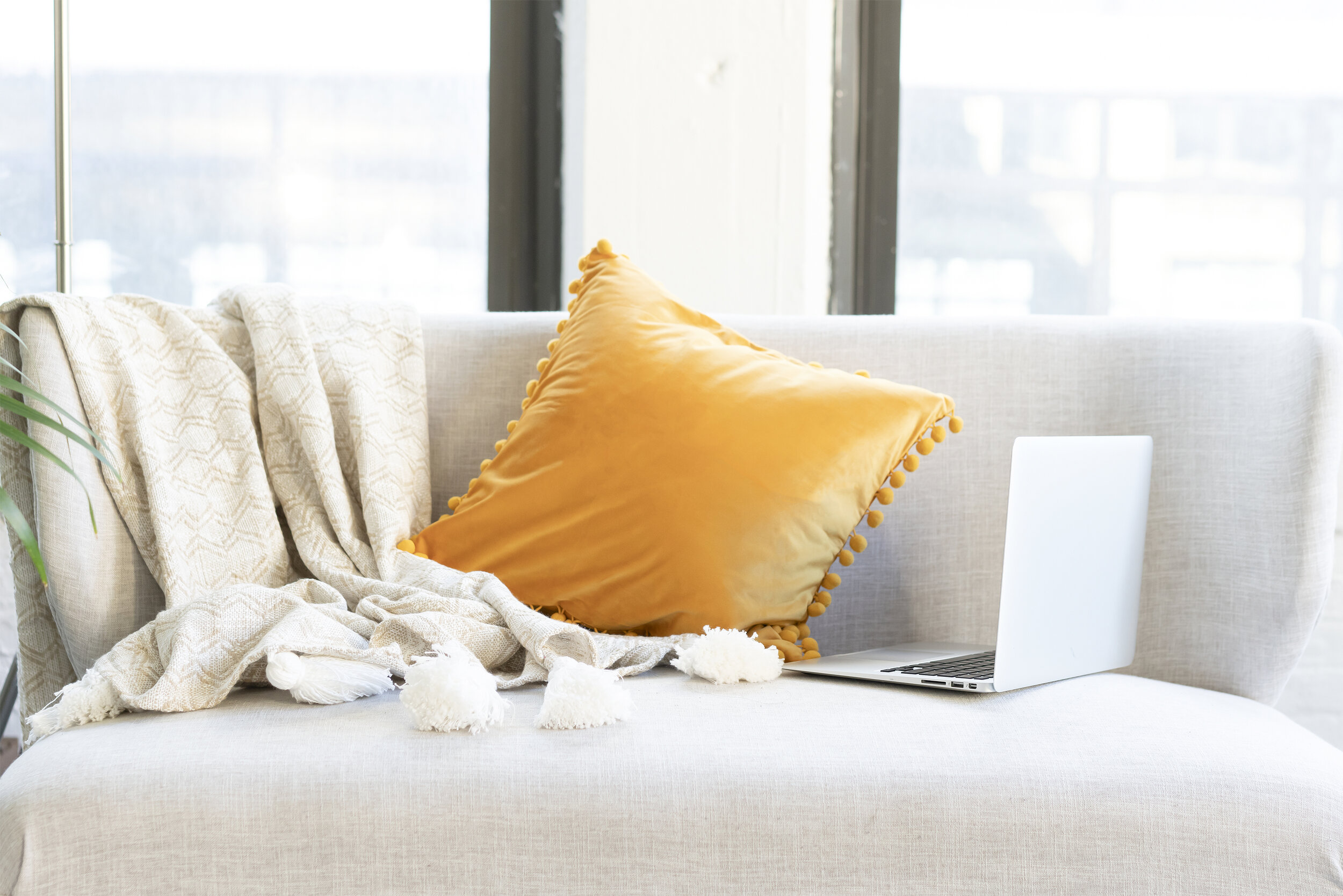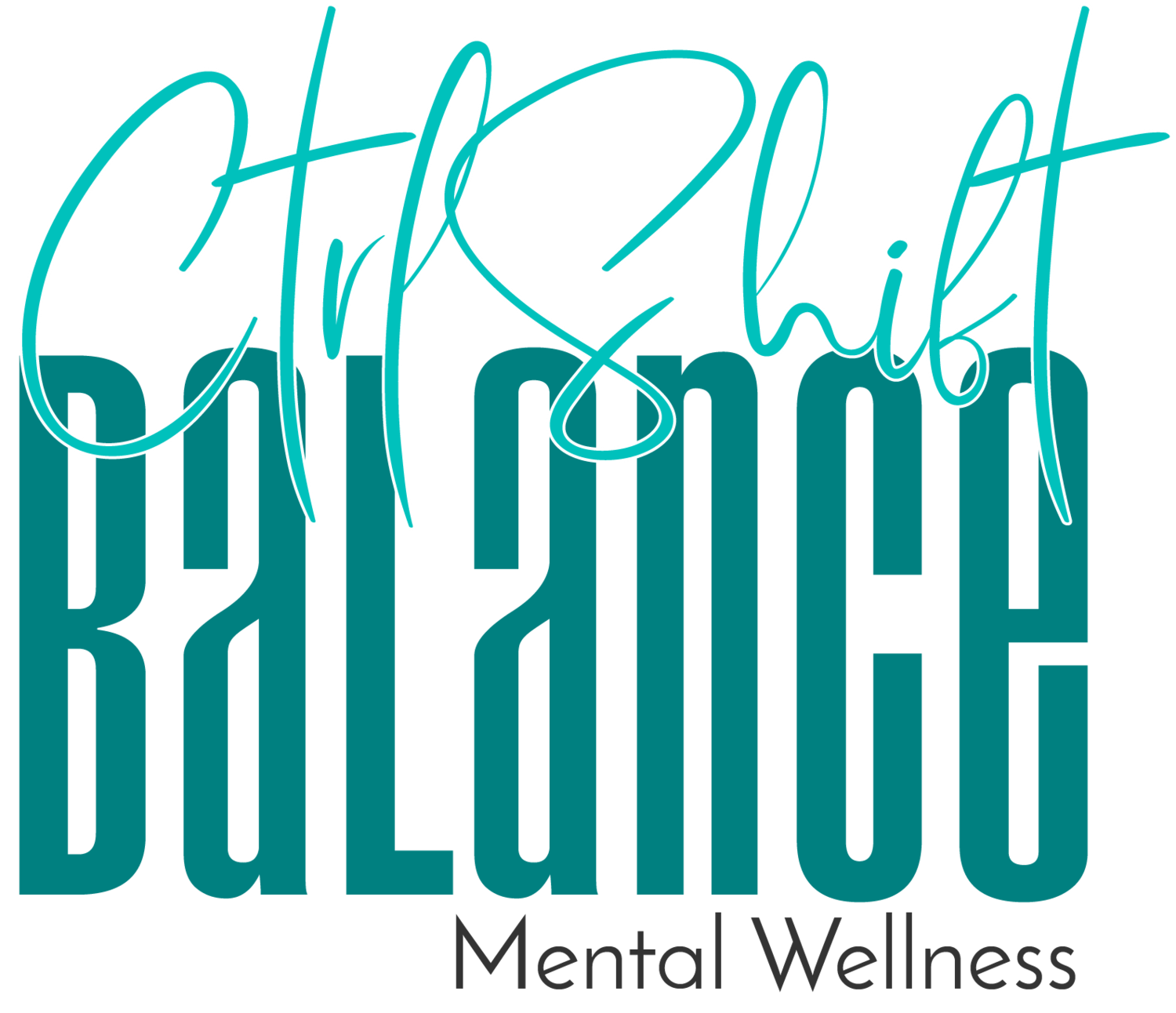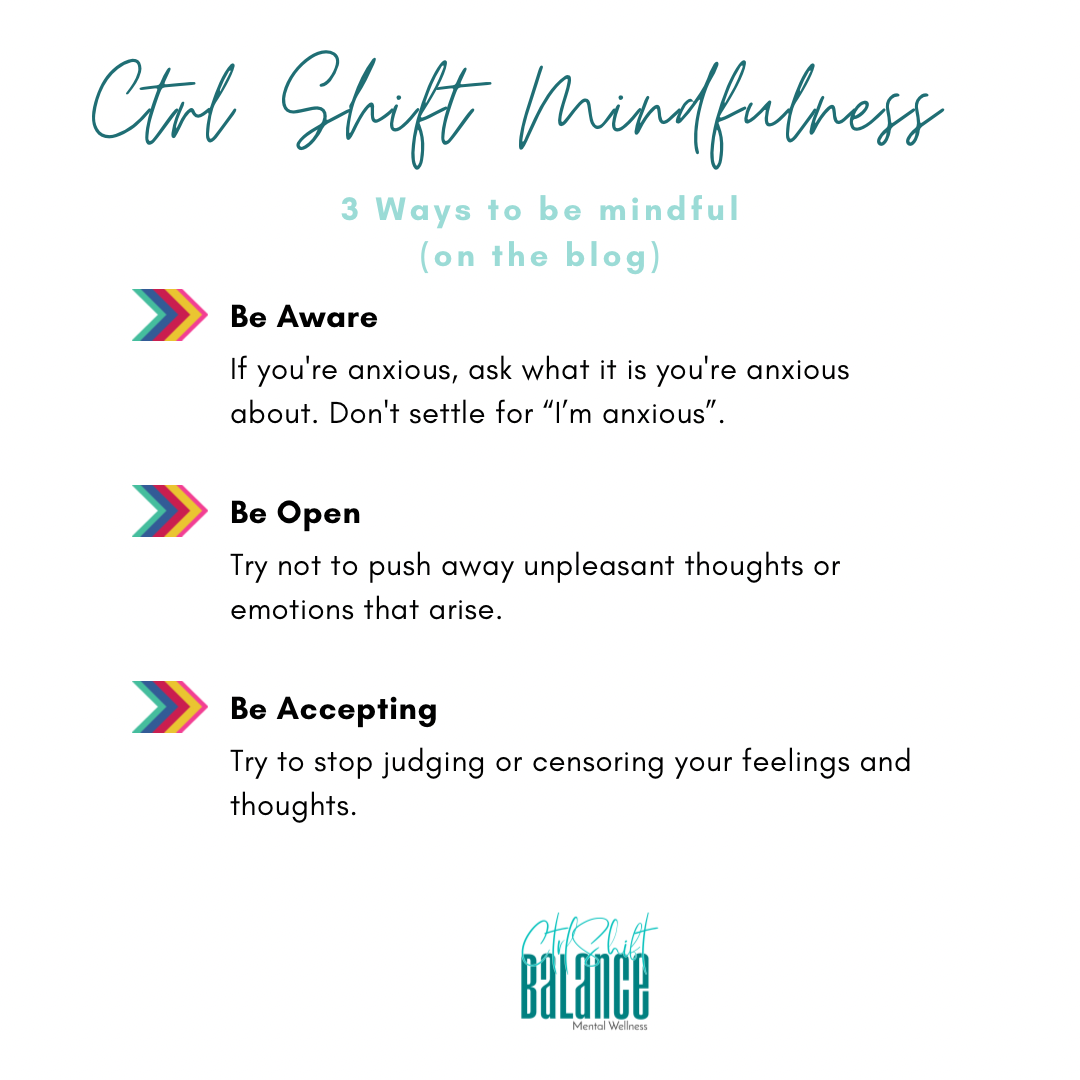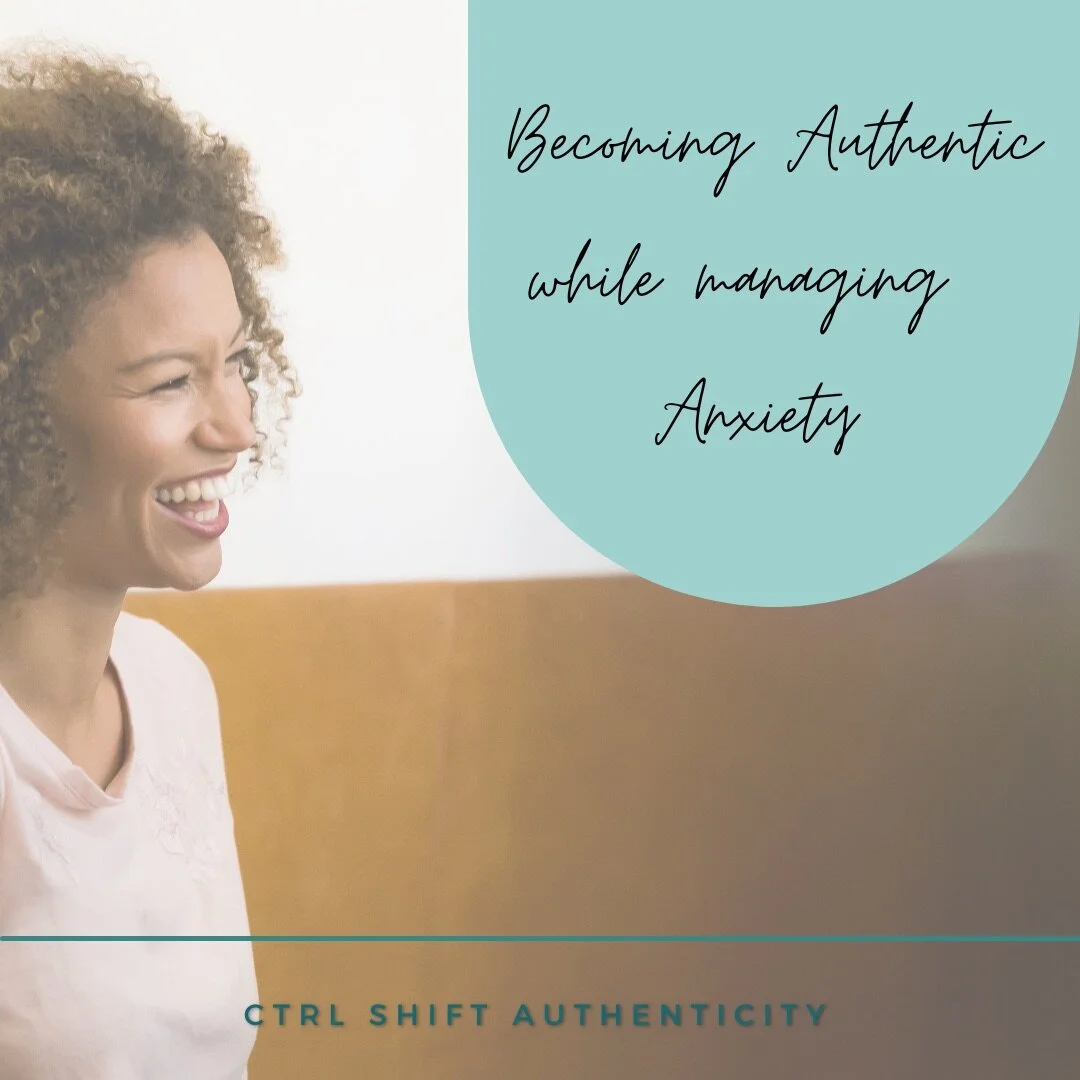
Ctrl Shift mindfulness
How to be more open, aware & present. Mindfulness—the practice of paying attention and staying present in the moment—has increasingly gained popularity in recent years. Perhaps this is because instead of spending even a second alone, staying present with our thoughts, we reflexively turn to our cell phones (I’m guilty of it at times) for entertainment, comfort, or distraction. Many of us are on our phones at work, in the bathroom - moments that in the past might have been spent unintentionally being mindful.
So how do we reclaim those mindful moments and again learn how to stay present, aware, and accepting of those moments?
Create Mindful Moments
Mindful moments are just small pauses in the business of life. They can be as short as a few breaths or as long as 10 or so minutes where we are actively present in the moment. Turn off the thoughts about the past or future and just notice what’s happening all around you. How do you feel? How do things look? How do things taste? etc...
The thing about being present and really paying attention is that we learn things about ourselves and our world that we might have been avoiding, perhaps with good reason. But we can deal with these thoughts and feelings once they come into the light.
When we try to just cope with emotions—like anxiety—the causes remain intact. Because mindfulness can help us better uncover and get at the causes, it can be a more effective way to increase well-being. But it’s important to note that mindfulness isn’t easy, so if it doesn’t work for you, that’s completely okay too.
Research suggests that people with severe trauma, depression, and other challenges like self-harm sometimes struggle with mindfulness. This is understandable since the roots of this emotional pain may be a lot harder to look at and deal with than other types of emotional pain. Please seek the support of a therapist if this is you and you want to use mindfulness.
How to Be Mindful
Even though mindfulness is theoretically possible to practice anywhere, that doesn’t mean it comes easy. Here’s some helpful tips:
To be more aware: If you're mad, ask what you're really mad at. If you're sad, ask what it is you're really sad at. If you're anxious, ask what it is you're anxious about. Don't settle for, "I'm mad at Devin because he was rude to me." Why does that rudeness matter? Why now? Why him? What is happening inside of you that makes you mad?
To be more open: Try not to push away unpleasant thoughts or emotions that arise. You might feel scared to cry in front of others or yell when you're angry. Try not to stifle those emotions. Instead, ask what might be leading you to stifle them. But also try not to generate excess emotions. Are you crying or yelling to get a specific reaction out of someone else? What are you hoping to achieve with your reactions? Try to stay present so you can just experience yourself as you are instead of trying to contort it into some kind of box.
To be more accepting: Try to stop judging or censoring your feelings and thoughts. Seriously, stop it! You may have heard judgy statements like “Boys don’t cry” or “You’re too sensitive” or “Get over it”, and you will, very likely, continue to hear these things. All you can do is refuse to judge yourself (or others), for having emotions. Emotions are natural and we all deserve ours.
Do a Quick Mindfulness Practice
Right now, try to create some negative emotions in yourself. An easy way to do this is to watch a movie or online video clip with a sad or emotional scene. Or if you’d like to challenge yourself, you could imagine something in your own life—for example, failing at something, being embarrassed in front of a crowd, or an injustice experienced by others that bothers you.
Once you have drummed up some negative emotions, stop thinking about the negative experiences and just be. See if you notice any interesting body sensations, emotions, or thoughts. Practice not ruminating on the experience but also not pushing the emotions away. Just be with yourself until your thoughts and emotions trail off.
If you finished this blog article feeling shaky, upset, or overwhelmed, mindfulness may not be for you. If, on the other hand, you feel more centered, calm, and content, keep using mindfulness to improve your life.
You may have additional questions on incorporating mindfulness in your day to day, let’s connect.
Your Partner in Balance,
Shayla Peterson
Ctrl Shift Your HABITS
Are you ready to create new habits?
Deciding to adopt new habits sounds good on paper, but in reality it can be challenging to put them into motion. How many times have you tried to exercise on a regular basis, only to find yourself back on the couch after few days or weeks. To be honest, I am guilty of it myself.
Let me share with you 7 strategies that will make implementing and maintaining new habits easier for your growth this Spring.
Chose the time & place. Many positive habits will be centered on a time, place or both. When you set a specific time and place to perform your new habits is key to become a regular part of life. EXAMPLE: Exercise in the morning before work or mediation in evening in the spare room.
Start with one habit at a time. It is natural to resist change or get super excited and want to implement everything all at once. Trying to change too much at once can create barriers towards lasting change. Simply Begin with a single habit. When you are performing and that habit is reliable, then add another. I encourage you to continue this until you have incorporate all the habits that you believe will relive your stress and promote balance in your life. Don’t forget to extend compassion as some new habits take longer than others. That is completely okay!
Start with the easier habit first. Yes, you have control over which habit that your will start with and with starting with the easier first, increases your odds of success. Start with the easiest to perform religiously to promote mastery. The little burst of success will encourage you to add more.
Understand your why. Consider each habit and what it will add to your life. If you are unable to see the benefit in a particular habit, you will be unlikely to stick with it. Remind yourself of the importance of the habit increases your chances in of being successful in this area whether is personal development, occupational, financial, recreational, etc.
Reward yourself. As you reach each milestone. Take a moment to cheer yourself on, dance party, praise break or reward just yourself. Keep it small but do it often (a weekly check is highly suggested).
Focus for 30 Days. It takes 21 to 30 days to create a new habit. Do everything that you can do to successfully get through the next 30 days. What would June 1 look like if you went hard on goals, new habits for 30 days or intentions. Whew! That will be a great feeling. I also want to share with you be easy if you miss a day or two, offer yourself compassion and get back on it on the next day.
Have Reminders. Habits are easier to create if we have something to remind us to do them. A good trigger is something that automatically happens each day. EXAMPLE: Get up, get dressed up, put on make up, drink coffee. What will your reminders look like?
Prepare. Setting new habits will require planning. If you are going to exercise in the morning, set alarm to wake up earlier, have your workout clothes at the end of the bed. Planning ahead and implement the necessary preparation to ensure your success.
New Habits can be challenging to develop, but strategies will make it go smoothly. You are invited to a free 15 minute consultation if you need a jump start on developing and reaching new habits in mental wellness.
Also visit the Wellness Shop for Ebooks and our most popular digital downloads for your mental wellness journey.
Your Partner in Balance & Wellness,
Shayla Peterson, LCSW, LISW-CP
Ctrl Shift manage ANXIETY
When it comes to anxiety, many studies show that women are more likely to suffer it than men. The obvious reasons for this are brain chemistry and hormonal fluctuations. Also, men and women deal with anxiety differently.
If we’re being honest, there is no way to “fix” anxiety. It stays with you one way or another and all that you can do about it is learn how to Ctrl Shift & manage it.
Over time, many women have gotten to know anxiety better. They finally figured out what works for them when it comes to overcoming it. Knowing the tools available is a good first step when dealing with anxiety.
So, what should we do? Check out the list below on ways to manage anxiety with self-care.
GET ENOUGH SLEEP
Needless to say, sleep gives your mind and body to heal. Yet, most people don't get enough sleep. They often sacrifice a healthy seven to nine hours of sleep to keep up with the demands of the world. Start working towards getting appropriate sleep regularly. This will help maintain healthy emotional and social functioning.
RUNNING
Don’t you think that there’s something magical about getting up at 5 or 6 in the morning? And getting dressed half-asleep, going out, and having a run around the neighborhood? You get to observe the city and nature waking up, so quiet and so peaceful. You get rid of all tension, negativity, and stress before the day begins. You then become more relaxed, calm, and ready to face the day.
This is why many women found running as their way to cope with anxiety. This is also because research proves that regular exercise reduces the risk of chronic disease. It improves self-esteem and reduces the symptoms of both depression and anxiety.
POSITIVE AFFIRMATIONS
Having positive self-talk with yourself helps in altering your subconscious thoughts. When anxious thoughts begin to set in, affirmations help you adopt a positive mindset. Positive thoughts affect your reality. They can create an energy and perspective that shape your actions.
MEDITATION & BREATHING EXERCISES
Learn to clear your mind through meditation. Start by focusing on your breath and body sensations. Furthermore, evaluate your thoughts as they enter your mind. These techniques are proven to reduce anxiety.
Unfortunately, there is no quick fix to battling anxiety. It’s something that you’ll need to learn how to manage every day. But we can be grateful that there are many solutions to help reduce its presence in our lives.
If you feel like there’s more you want to add or you want to share your story, connect with me and let’s create an emotional wellness plan for you today.
If you would like additional resources to help you manage your Anxiety, check out resource guide or ebooks to kickstart your journey.
Your Partner in Balance & Wellness,
Shayla Peterson, LCSW, LISW-CP
Ctrl Shift AuthentIcity
Being your authentic self can feel risky now in our screen-obsessed world. We’re just trying to fit in, be liked, and be accepted by other human beings. And as a result, the image we present (on our social media profiles and IRL) have become mere presentations of who we think we should be and not reflections of who we really are. So how do we take off the mask we've been wearing and start to live a life of authenticity?
1. Observe yourself objectively
Learn to observe yourself like a fly on the wall. Watch yourself, observing how the version of yourself that you show the world behaves, what it believes, how it reacts under pressure, and how it responds to challenges. Practice noticing which of these responses feel authentic, and which ones feel inauthentic. By identifying which responses are just “for show” vs authentic, you can begin to notice the falseness and begin to better see the truth underneath.
2. Examine family belief systems
Think back to episodes in your childhood, episodes that led you to stop being your authentic self and instead adopt some other way of existing in this world. By examining where our behaviors come from, we can learn a lot about our authentic selves.
3. Identify discrepancies
Try to become aware of discrepancies between your actions and your beliefs. If you catch yourself making a remark that makes you cringe, ask yourself whether you really believe the words you speak. Are you just saying these things because someone else taught you to?
If you acknowledge what is true for you now, then you can better live your life according to the needs of your Authentic Self. But that kind of authenticity requires self-awareness and self-honesty.
4. Examine your doubts
When exploring your Authentic Self, you may feel unsure of how to go about it. You may question whether it's even possible to change what feels so deeply ingrained within you or is invisible to you. So keep an eye out for feelings of doubt.
Doubts can be like breadcrumbs that lead you to your Authentic Self. If you doubt something—a thought, behavior, emotion, experience—reflect for a moment to find whatever is underneath. Is your Authentic Self trying to tell it to "stop it?"
5. Face your fears
Humans tend to be most comfortable with what is familiar. The unfamiliar is often challenging, at least at first. Examining your core beliefs can be like exploring a foreign landscape you are unfamiliar with.
Our Authentic Self often has a lot of fear, sadness, and anger—our true selves were hurt and that's why they hide. However, the difficult secrets we hide from ourselves are what make us who we really are. So as much as possible, and as slowly as you need to, courageously explore the truth of what makes you who you are. Identifying, experiencing, accepting, and letting go of these buried emotions is exactly what fuels your Authentic Self.
6. Explore your values
Integrity, ethics, and living our values is an effective way to live more authentically. The trouble comes when we are so far from our Authentic Selves that we do not even know what our values are. So explore your values and figure out some ways to start living them.
7. Love yourself
Because it takes self-love for our Authentic Selves to emerge, embedding more love and compassion for yourself is helpful. One way to increase your self-love is to set aside some time aside to take numerous deep breaths each day. You can add this into an existing meditation practice if you like.
Slowly deepen your breathe and when you are feeling fully relaxed and receptive, call love to yourself from your environment. Imagine each breath infused with loving energy. Whether as balls of energy, or bursts, or rays of light and love, invite love to enter your body via your breath. Draw love into your lungs and disperse it throughout your body, or send it directly to your Authentic Self. Keep breathing consciously until you feel the lightening and lifting energy of these "love breaths."
Once filled with love, share some of it with friends or loved ones. Sending love to others tends to expand the love within!
With Alignment & Authenticity,
Shayla Peterson, LCSW, LISW-CP






